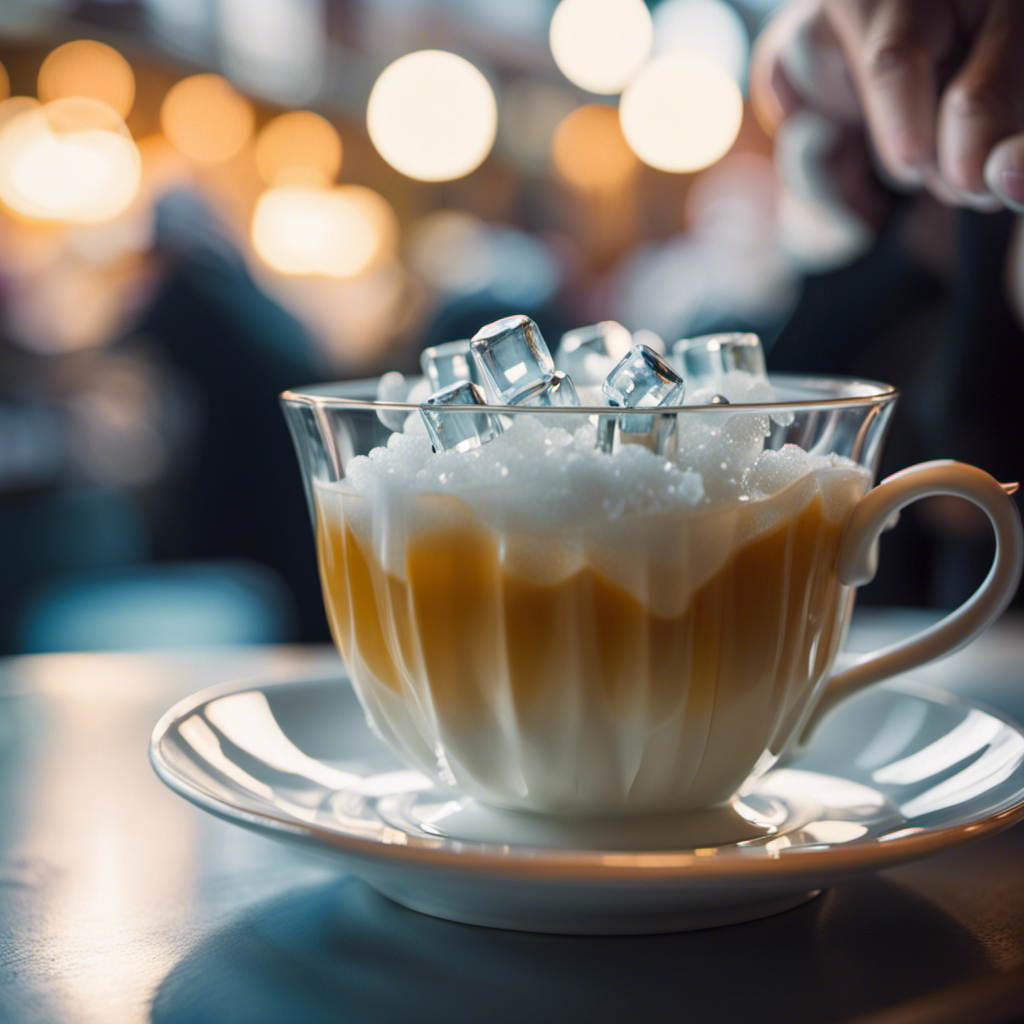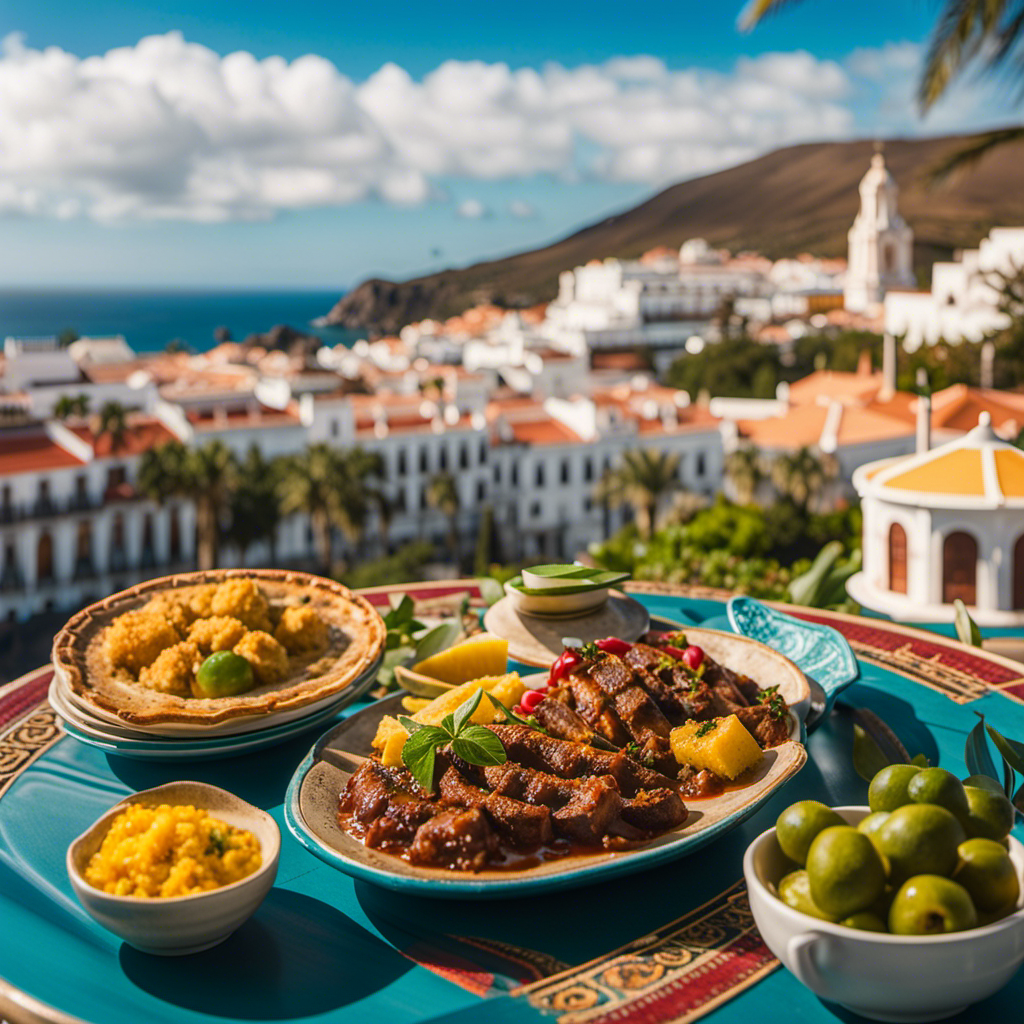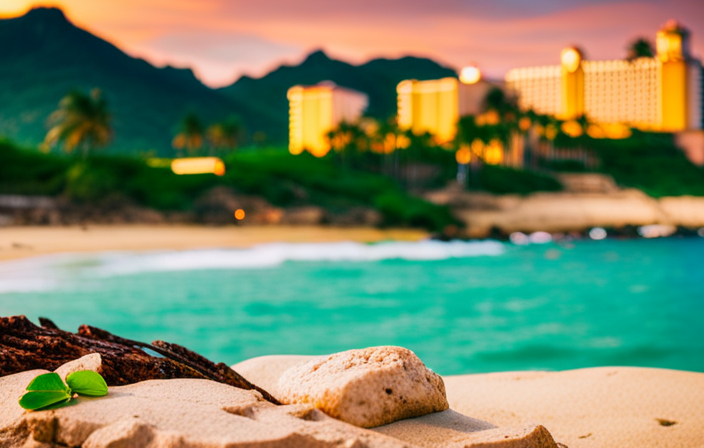As a passionate traveler, I have always been fascinated by the unique cultural traditions and peculiarities I encounter on my journeys.
One such quirk that has piqued my interest is the absence of ice in European drink service. It seems that Europeans have a preference for room temperature beverages, believing that cold drinks may not be good for digestion. Ice is seen as a luxury, a rarity rather than a standard.
In this article, we will delve into the reasons behind this unique practice and explore the fascinating world of drink service in Europe.
Key Takeaways
- Ice is considered a luxury and not commonly served in Europe.
- Europeans prefer to serve drinks at room temperature.
- Ice is viewed as unnecessary and wasteful, and the absence of ice is seen as a way to appreciate the original flavors of the drink.
- Ice alters the taste and masks the true flavors of a drink, according to beverage purists.
Ice as a Rarity
Ice is considered a luxury and not something that is commonly served in Europe. As I traveled through various European countries, I noticed the scarcity of ice in beverages. It seems to be a cultural preference to serve drinks at room temperature.
This preference may stem from the belief that cold drinks can dilute the flavors or disrupt digestion. Europeans seem to enjoy the taste of slightly warm drinks and view ice as unnecessary and wasteful.
It is interesting to observe how different cultures have distinct preferences when it comes to drink temperature. In Europe, the absence of ice in beverages is not seen as a lack, but rather as a way to appreciate the original flavors and savor the drink as it is intended to be enjoyed.
The Melting Dilemma
As a traveler in Europe, I often find myself grappling with the dilemma of my drink becoming diluted when it gets too warm. The impact of climate on ice consumption and the role of cultural traditions in drink service are fascinating aspects of European dining. In many European countries, ice is not commonly served due to various reasons. It is believed that ice melts and waters down the drink, which is seen as undesirable. Additionally, Europeans prefer the taste of slightly warm beverages and view ice as unnecessary and wasteful. This cultural preference for room temperature drinks is deeply rooted in tradition and superstition. Despite the invention of refrigerators, ice never gained popularity in Europe. Understanding and adapting to these cultural quirks adds to the unique experience of European dining.
| Impact of Climate on Ice Consumption | Role of Cultural Traditions in Drink Service |
|---|---|
| Ice melts quickly in warmer climates | Europeans prefer room temperature drinks |
| Ice is seen as unnecessary and wasteful | Cultural preference rooted in tradition and superstition |
| Limited access to ice in certain regions | Ice never gained popularity in Europe |
Warm Drinks and Digestion
When traveling in Europe, I often wonder about the impact of warm drinks on digestion. It is interesting to observe the cultural differences in drink preferences and how they relate to health.
In many European countries, warm drinks are the norm. Unlike in other parts of the world where ice is commonly used, Europeans prefer their beverages at room temperature. There is a belief that cold drinks may not be good for digestion, according to superstition. This preference for warm drinks is deeply rooted in their culture and traditions.
It is fascinating to see how something as simple as the temperature of a drink can vary so greatly across different societies. As I continue my journey through Europe, I am eager to learn more about the cultural significance of warm drinks and their impact on health.
Ice: Luxury or Necessity?
I appreciate the differing perspectives on whether or not ice is considered a luxury or a necessity in various parts of the world.
It’s fascinating to observe how different cultures perceive and utilize ice in their drink service. In Europe, where ice is not commonly served, there is a cultural significance attached to its absence. Instead of relying on ice for cooling, Europeans have developed alternative methods that prioritize the taste and original flavors of their beverages.
It’s interesting to note that some argue that ice melts and dilutes the drink, while others believe that cold drinks may not be good for digestion. Ice, therefore, is seen as unnecessary and wasteful, and its absence is considered a mark of authenticity. Europeans have embraced room temperature drinks, embracing the local customs and preferences for drink temperature.
The Battle of Beverage Purists
For purists, altering the taste of a beverage with ice is considered sacrilegious. The importance of tradition and the role of cultural identity in drink service cannot be underestimated.
In Europe, where ice is not commonly served, there is a battle between those who see it as a luxury and those who prefer their drinks as they are. Beverage purists argue that adding ice waters down the drink and masks its true flavors. They believe that drinks should be enjoyed in their original form, without any alterations.
This mindset reflects a deep respect for tradition and a desire to preserve cultural identity. While some may see it as a matter of personal preference, for purists, it is about honoring the customs and heritage associated with the beverage.
Taste Vs. Dilution
In my opinion, the battle between beverage purists and those who prefer ice comes down to the balance between taste and dilution.
Ice preservation is a key factor in this debate, as some argue that ice can alter the true flavors of a drink.
On the other hand, cultural preferences play a significant role as well. In Europe, for example, ice is not commonly served, as locals prefer their drinks at room temperature. They believe that cold drinks may not be good for digestion and that slightly warm drinks enhance the taste. Europeans see ice as unnecessary and wasteful, considering it a luxury rather than a standard service.
Ultimately, the battle between purists and ice enthusiasts highlights the clash between preserving the original taste of a beverage and the desire for a refreshing, chilled drink.
Overcoming Language Barriers
As I continued my exploration of the cultural quirks of drink service in Europe, I found myself facing a new challenge: overcoming language barriers.
It became evident that effective communication was essential in navigating the differences in drink preferences and customs. The inability to speak the local language posed a potential hurdle, but I discovered that simple gestures and phrases could bridge the gap.
Polite requests for ice were met with understanding, as locals recognized the preference for cold drinks. Maintaining a respectful and considerate demeanor proved to be key in gaining cooperation from establishments.
Despite the language barriers, I found that cultural communication could be achieved through a mutual understanding of the importance of embracing and adapting to local customs. This exchange of understanding allowed me to fully immerse myself in the unique experience of European dining and drinking customs.
Polite Requests for Ice
When politely requesting ice, I found that simple gestures and phrases were effective in communicating my preference for a cold beverage. In some European countries where ice is not commonly served, it can be a challenge to convey this preference. However, by using a few key tactics, I was able to successfully request ice in these situations.
Here are three strategies that worked for me:
-
Non-verbal cues: Sometimes, words may not be necessary to convey your desire for ice. A simple pointing gesture towards the ice bucket or mimicking the action of stirring a cold drink can effectively communicate your preference.
-
Polite phrases: Using polite phrases in the local language, such as ‘Could I please have some ice?’ or ‘Is it possible to get ice in my drink?’ can help convey your request in a respectful manner.
-
Flexibility: It’s important to understand and respect the cultural perceptions surrounding ice. If ice is not readily available or considered the norm, it may be helpful to be open to chilled alternatives like refrigerated beverages or asking for a cold glass to enhance the drinking experience.
Embracing Room Temperature
I have learned to appreciate and embrace the local preference for room temperature beverages. It is a fascinating cultural quirk that I have encountered during my travels in Europe.
The Europeans have a deep-rooted tradition of enjoying their drinks without the use of ice. At first, it was a bit surprising to me, coming from a culture where cold beverages are the norm. However, as I immersed myself in the local customs, I began to understand the reasoning behind this preference.
Room temperature drinks allow the flavors to shine through, providing a more authentic taste experience. It also aligns with the belief that cold drinks may not be good for digestion.
Cultural Adaptation in Drink Service
Adapting to local customs in Europe is important. It is crucial to understand and respect the unique preferences for how beverages are served. Cultural preferences and drink customs differ across countries and regions. It is fascinating to observe the various traditions.
Here are four interesting aspects of European drink service customs:
-
No ice: Unlike in other parts of the world, ice is not commonly served in Europe. Europeans believe that ice can dilute the taste of the drink and prefer slightly warm beverages.
-
Beverage purists: Some Europeans are purists when it comes to drinks. They believe that altering the taste with ice is a sin and that watered-down drinks are inferior. They argue that drinks should be enjoyed in their original form.
-
Polite request for ice: While ice may not be the norm, it is acceptable to politely ask for it in countries where it is not served. Locals may understand the preference for cold drinks and accommodate the request if available.
-
Embracing local customs: When traveling in Europe, it is best to embrace and adapt to the cultural differences in drink service. Try the local beverages as they are traditionally served and enjoy the unique experience of European dining and drinking customs.
Frequently Asked Questions
What Is the Historical Reason Behind Ice Not Becoming Popular in Europe Despite the Invention of Refrigerators?
The historical reason behind ice not becoming popular in Europe despite the invention of refrigerators is due to cultural preferences. Europeans prefer room temperature drinks and believe that ice can dilute the flavor and disrupt digestion.
Are There Any Health Benefits Associated With Drinking Room Temperature Drinks in Europe?
There are potential health benefits associated with drinking room temperature drinks in Europe. Cultural practices favor slightly warm beverages, which some believe aids in digestion and allows the true flavors of the drink to be appreciated.
How Do Europeans Perceive the Use of Ice in Cocktails or Mixed Drinks?
Europeans have varying opinions on ice in cocktails or mixed drinks. Some see it as unnecessary, while others embrace it as a refreshing addition. The cultural significance of ice in drinks reflects the diverse preferences and traditions across European countries.
Are There Any Specific Gestures or Phrases That Can Be Used to Request Ice in Countries Where It Is Not Commonly Served?
In countries where ice is not commonly served, it is acceptable to politely request it. Locals may understand the preference for cold drinks, and simple gestures or phrases can overcome language barriers.
What Are Some Traditional European Beverages That Are Best Enjoyed at Room Temperature?
Some traditional European beverages, like red wine and herbal liqueurs, are best enjoyed at room temperature. This cultural preference stems from the belief that cold drinks can alter the taste and hinder digestion.
Meet Asra, a talented and adventurous writer who infuses her passion for exploration into every word she writes. Asra’s love for storytelling and her insatiable curiosity about the world make her an invaluable asset to the Voyager Info team.
From a young age, Asra was drawn to the power of words and their ability to transport readers to far-off lands and magical realms. Her fascination with travel and cultures from around the globe fueled her desire to become a travel writer, and she set out on a journey to turn her dreams into reality.











